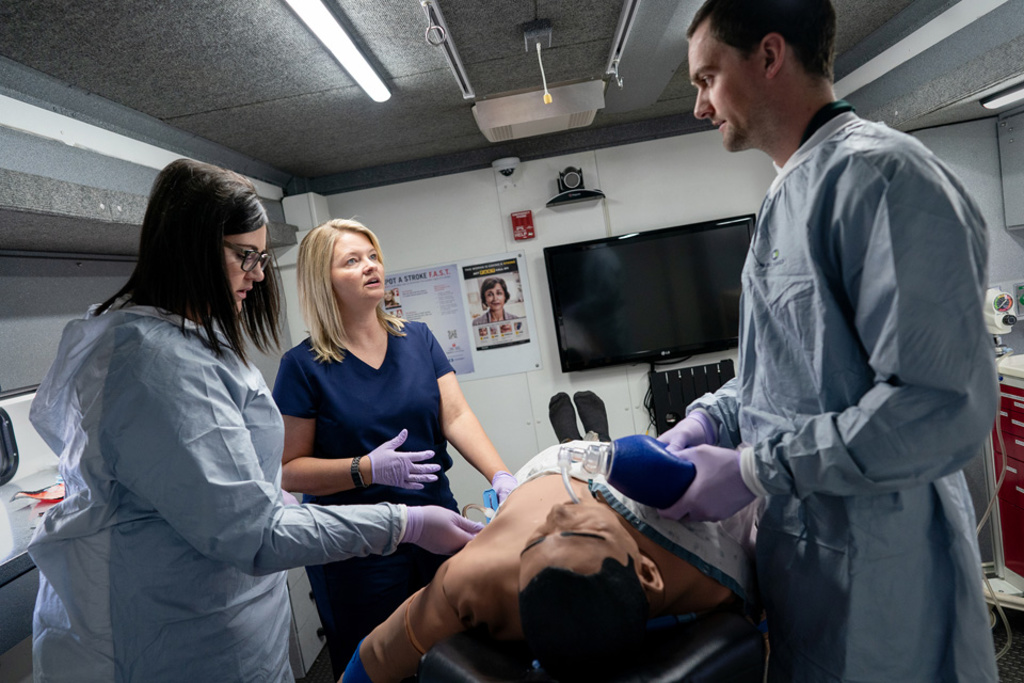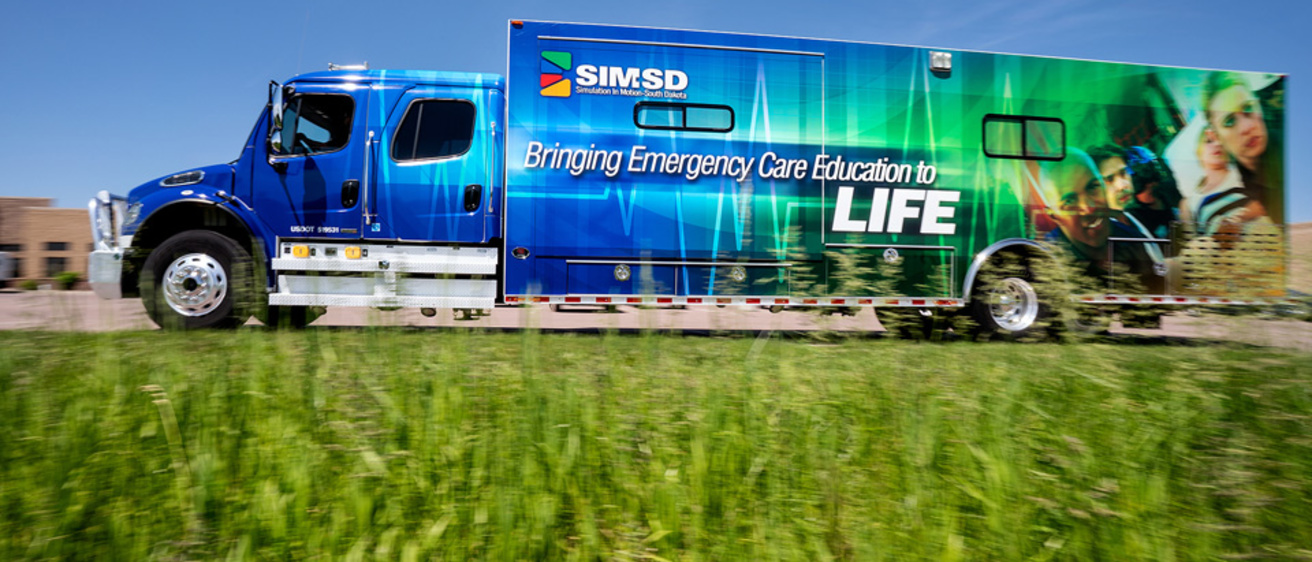A new $8 million grant from the Leona M. and Harry B. Helmsley Charitable Trust will help the University of Iowa educate health care providers and first responders in rural parts of the state on procedures they don’t often have the opportunity to perform.
The Simulation in Motion-Iowa (SIM-IA) program will provide valuable hands-on experience for health care professionals using a truckful of state-of-the art equipment and patient simulators.
“We are thrilled to partner with the University of Iowa to bring simulation education to communities across the state,” says Walter Panzirer, a trustee of the Helmsley Charitable Trust. “Our rural emergency medical responders and rural hospitals face many obstacles, including costs, travel distance, and time off to getting critical education. Soon the education will come to them in their communities.”
The declining number of patients in rural areas means that first responders and health care providers have fewer opportunities to practice certain procedures, so they may not be fully comfortable when called upon. Simulation-based education, meanwhile, is expensive and often requires lengthy travel.
“We want communities to tell us what the priorities are in their area rather than simply bringing them a generic approach that might not fit their needs. We’ll tailor the education to what the community providers need.”
—Jacinda Bunch, assistant professor in the University of Iowa College of Nursing, who will co-direct the SIM-IA program
“In rural areas, first responders don’t often get many calls for service, so they can go months or years without seeing some situations,” says Jacinda Bunch, assistant professor of nursing, who will co-direct the SIM-IA program.
The grant from the Helmsley Charitable Trust to the UI College of Nursing will allow University of Iowa health care professionals to support local agencies educating first responders and care providers in their own backyards for those seldom-seen situations.
“Thankfully, crisis situations do not happen often in most communities, but when they do, rapid responses and skilled, experienced professionals are needed,” says Cormac O’Sullivan, a clinical associate professor of nursing and director of the college’s anesthesia program who will co-direct SIM-IA with Bunch.
The college will use a portion of the grant money to purchase three vehicles, each about the size of a semi-trailer truck and equipped with a simulated ambulance cab, a simulated emergency room, and a control room. University health care professionals will take the education on the road so first responders and health care professionals can sharpen their skills without the expense and hassle of travel.
“They’ll look just like an ambulance or an ER and have everything you’d expect to see in an ambulance or an ER, and first responders can practice their skills in a safe place using high-tech tools,” says Bunch.
The “patients” are technologically advanced mannequins attached to the control room, where educators from the College of Nursing and Carver College of Medicine can change the simulation on the fly by simulating any number of complications. It could be a heart attack, for instance, a severe hemorrhage, or even a reaction to a medication.
“There are lots of things that can go wrong in an emergency that responders need to be prepared for, and these trucks can address all of them,” says O’Sullivan.

Bunch says the organizers performed needs assessments by talking with emergency medical personnel from communities across the state, including Pella, Washington, Storm Lake, Orange City, Clarinda, and others. Almost all said they would be enthusiastic participants, but the type of education needed varied by community.
“We want communities to tell us what the priorities are in their area rather than simply bringing them a generic approach that might not fit their needs,” says Bunch.
For instance, many rural hospitals no longer maintain delivery rooms, so women about to give birth are sent to larger, regional hospitals and the only deliveries they perform are in an emergency. However, since those are relatively rare, Bunch says many health care providers have minimal experience with labor and delivery.
Other educational scenarios they’re developing are for heart attacks and cardiac events, traumatic farm injuries, sepsis, bleeding, airway obstruction, medication errors, and pediatric emergencies.
“We’ll tailor the education to what the community providers need,” says Bunch.
Maureen Ewinger, director of education and organizational development at the Henry County Health Center in Mount Pleasant, Iowa, has been part of the initial planning process and looks forward to the education provided by SIM-IA, especially for their young nurses working their first jobs.
“A lot of the procedures and situations in a Critical Access Hospital, we don’t get much exposure to,” says Ewinger. “This is a chance to give our staff experience in those situations while in a safe environment.”
She says the education she’s most interested in for her staff are invasive procedures, such as intubation or chest tube placement, and addressing injuries from falls, farm accidents, and orthopedic emergencies. Ewinger says the hospital currently participates in trauma-education programs provided by University of Iowa Hospitals & Clinics. They also recently built their own in-house ER simulator that can be incorporated into the SIM-IA program.
The Helmsley Charitable Trust has invested more than $49 million in rural health care initiatives across Iowa.
“We are thankful for the tremendous support of all the partners who have made this possible, including Gov. Kim Reynolds, the Iowa Department of Public Health, the University of Iowa, numerous hospitals, and many others,” says Walter Panzirer, a trustee of the Helmsley Charitable Trust.
“You can’t not have enough education,” she says.
To date, Helmsley has invested $32 million to bring world-class education using state-of-the art patient simulators to rural communities. Helmsley has funded similar programs in Nebraska, North Dakota, South Dakota, and Montana. Those have gone well, Bunch says, and the Iowa organizers have been developing their program based on what has worked and what hasn’t.
O’Sullivan says they plan to work in tandem with local organizations, agencies, and community colleges to support and augment the educational programs already in place. Iowa educators can work with other local hospitals, clinics, schools, police and fire departments, sheriff’s departments, National Guard units, or any organization that can benefit from hands-on emergency education.
“Our goal is to provide some level of education and hands-on training to everyone who will be touching a patient,” he says.
O’Sullivan says they hope to turn their visits into community events as well, with open houses and other programs that raise public awareness.
Aside from purchasing and maintaining the vehicles, the grant will also provide funding to offer the education at little to no cost to local agencies when the program launches. Bunch and O’Sullivan are working to secure permanent funding from other sources so they can continue to offer the program to any community that wants it after the grant ends in three years.
The program is expected to begin in the summer of 2022 after the mobile simulation centers have been delivered.
